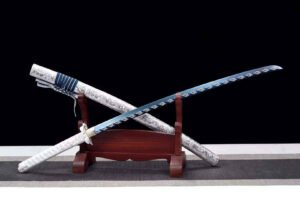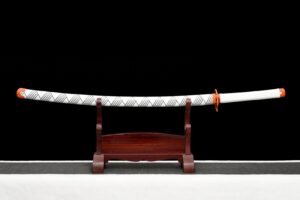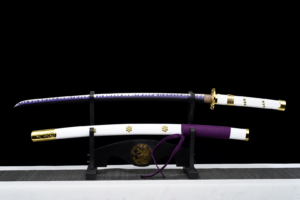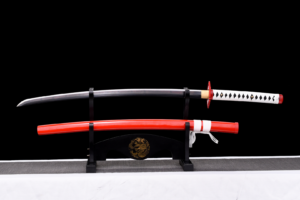A katana is much more than a mere weapon. It is a symbol of Japanese honor and history. For collectors and martial arts enthusiasts, displaying a katana properly is a matter of respect and tradition. In this article, we will explore how to present a katana appropriately, with a focus on the katanakake, the traditional stand used for centuries.
The Katanakake: The Traditional Stand
What is a Katanakake?
The katanakake is a wooden stand specifically designed to display katanas. It is equipped with hooks to hang one or two swords. Used by samurai during feudal Japan, the katanakake allowed the swords to be placed safely before entering a building.
Types of Katanakake
There are several types of katanakake, ranging from simple wooden stands to more ornate and decorative models. Some are designed for a single sword, while others can hold multiple swords. When choosing a katanakake, it is important to consider not only its aesthetics but also its stability and its ability to protect the sword.
Traditional Display Rules
Blade Facing Up
Traditionally, katanas are displayed with the blade facing up. This practice, inherited from feudal Japan, is a mark of respect towards the weapon. Additionally, displaying the blade facing up helps protect the cutting edge from damage.
The Position of the Tsuka
The tsuka (handle) of the katana can be oriented to the left or right when displayed. According to Japanese tradition:
- Tsuka to the left: Symbolizes peace. This is the most commonly used position, as it indicates that the sword is not in a combat-ready state.
- Tsuka to the right: Indicates preparation for combat. This position is less common and is often used to show that the sword is ready to be drawn.
Katana Maintenance
Regular Cleaning
To keep a katana in good condition, regular cleaning is essential. Dust, debris, and moisture can cause rust and other damage to the blade. Use a soft cloth to wipe the blade after each display.
Polishing and Oiling
In addition to cleaning, polishing and oiling are crucial for katana maintenance. Polishing helps maintain the blade’s shine, while oiling protects against rust. Use special katana oil and apply it sparingly with a soft cloth.
In Summary
Displaying a katana is a task that requires attention and respect for traditions. The choice of katanakake, the orientation of the blade and tsuka, as well as the regular maintenance of the sword, are all factors that contribute to the proper presentation of this iconic weapon. By following these guidelines, you can not only honor the history and culture of the katana but also preserve the beauty and integrity of your sword for years to come.






